December 2, 2016
Air Date: December 2, 2016
FULL SHOW
SEGMENTS
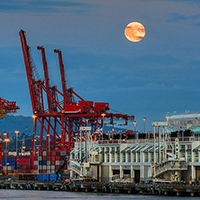
Canada Climate Masterplan
View the page for this story
This week Canada pushed forward on its initiative to rid the country of coal-fired power plants by 2030, and put a minimum national price on carbon by 2019. At the same time, the Trudeau administration rejected a new tar sands pipeline but approved the expansion of two pipelines that already bring oil sands crude to refineries in British Columbia and Wisconsin. Host Steve Curwood caught up with David Heurtel, Minister of Sustainable Development, Environment and the Fight Against Climate Change in Québec Province, to talk about present and future carbon markets, the future for coal and Canada’s climate stewardship efforts. (14:00)

Beyond The Headlines
/ Peter DykstraView the page for this story
Peter Dykstra tells Living on Earth Host Steve Curwood about a bizarre incident involving asthma triggered by thunderstorms. Then, Shell’s CEO claims the Paris agreement won’t impact the company’s valuation, and in the history calendar they look back on a series of underground nuclear blast tests in Mississippi. (04:10)

Making Plastic Can Increase Pollution
/ Reid FrazierView the page for this story
Ethane is one of the most useful gases to the petrochemicals industry. But it needs some extra processing before it can become the ethylene used in plastics manufacturing, and Reid Frazier reports on how a new “ethane cracker” plant being built by Shell could bring more pollution to Pittsburgh region’s air. (10:20)

Note on Emerging Science: Engineering a High-Yield Soybean
/ Alexander MetzgerView the page for this story
Legumes are an important part of a balanced diet for billions of people around the world. A new and improved soybean plant may hold the key to greater food production without chemical fertilizers. Living on Earth’s Alexander Metzger discusses the botanical breakthrough in this week’s Note on Emerging Science. (06:00)

Jellyfish Are Taking Over!
View the page for this story
Dr. Lisa-ann Gershwin has a passion for the jellyfish she studies, and has discovered 200 new species. But the sea creatures she loves are blooming, clogging power plant ducts and beaches as well as overwhelming some marine ecosystems, and even stinging us! And it’s largely because of human impacts like overfishing, plastics pollution, and warming oceans. Living on Earth’s Helen Palmer took a trip to the New England Aquarium to find out more. (12:45)

BirdNote: Frigatebirds Are Seafaring, But Water-Averse
/ Michael SteinView the page for this story
Frigate birds are one of the only seabirds with feathers that are not water-proof, but as Michael Stein explains, their ability to stay airborne for weeks at a time makes up for that trait. (02:00)
Show Credits and Funders
Show Transcript
HOST: Steve Curwood
GUESTS: David Heurtel, Peter Dykstra, Lisa-Ann Gershwin, Michael Stein
REPORTERS: Reid Frazier, Alex Metzger
[THEME]
CURWOOD: From Public Radio International, this is Living on Earth.
[THEME]
CURWOOD: I'm Steve Curwood. Canada’s federal government has a plan to dump coal and price carbon, and it stands on the shoulders of provinces.
HEURTEL: One thing that's very important to remember is that in both the Canadian system and the U.S. system, states have the brunt of the jurisdictions having to do with the fight against climate change. Québec set up its cap and trade system with California while we had a national government that would not even say the words climate change.
CURWOOD: Also, Pennsylvania has its own cap-and-trade system for controlling air pollution, but the trading rules meant to clean up the air could actually be making it dirtier.
FABISIAK: I don’t see that as improving the air quality to any great extent. It’s like three steps forward, 2.99 steps back.
CURWOOD: That and more this week on Living on Earth. Stick around.
[NEWSBREAK MUSIC: Boards Of Canada “Zoetrope” from “In A Beautiful Place Out In The Country” (Warp Records 2000)]
ANNOUNCER: Support for Living on Earth comes from United Technologies. Innovating to make the world a better more sustainable place to live.
[THEME]
Canada Climate Masterplan
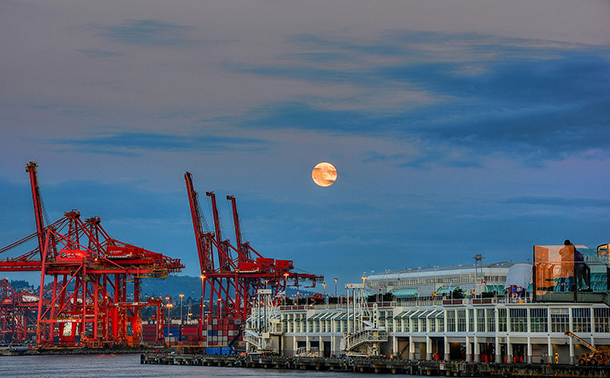
A harvest moon hangs over Coal Harbor, Vancouver B.C. (Photo: tdlucas5000, Flickr CC BY 2.0)
CURWOOD: From the Jennifer and Ted Stanley Studios at the University of Massachusetts, Boston and PRI, this is Living on Earth. I’m Steve Curwood. To keep promises made at the Paris climate summit, Canada is unrolling a master plan to deal with climate change, including a phase-out of coal by 2030 and a phase-in of carbon pricing by 2019. Provincial premiers and indigenous leaders plan to meet with Prime Minister Justin Trudeau on December 9 to seal the deal.
Mr. Trudeau has also nixed a controversial new pipeline to carry heavy tars sands oil from Alberta to the West coast. But he also approved the expansion of two existing pipelines that would carry the heavy crude from Alberta to refineries in British Columbia and Wisconsin. Mr. Trudeau says the Trans Mountain pipeline expansion planned by Kinder-Morgan to the west will meet the highest standards of environmental protection.
TRUDEAU: Aside from the many and obvious economic benefits, we approved this project because it meets the strictest of environmental standards and fits within our national climate plan. We will require that Kinder-Morgan meet or exceed all 157 of the binding conditions set out by the National Energy Board.
As for the phase-out of coal, all but four provinces have already stopped using it or committed to do so. Québec has led carbon pricing with a cap-and-trade program that is already linked to California and set to begin shortly with Ontario, and British Columbia already has a carbon tax. David Heurtel is Minister of Sustainable Development, the Environment and the Fight Against Climate Change for Québec, and he’s on the line now from Québec City. David, welcome back to Living on Earth.
HEURTEL: Great to be with you, Steve.
CURWOOD: What effect do you think phasing out coal will have on trade relations between the Canada and the U.S.? We have a new president coming in who really likes coal.
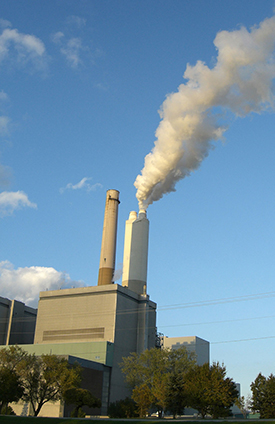
Smoke billows out of the now-defunct coal-fired generating station in Lambton, Ontario (Photo: Toban B., Flickr CC BY-NC 2.0)
HEURTEL: I think it's a clear signal from the Canadian government that from a national Canadian perspective our federal government is serious about the fighting of climate change, and that's a change from the previous federal government. But one thing that's very important to remember is that both in the Canadian system and the U.S. system -- states have the brunt of jurisdictions having to do with climate change. Québec set up its cap and trade system with California while we had a national government that would not even say the words climate change and we were able to develop this and have Ontario come on board and BC set up its carbon tax, and so while our federal government the same time was pulling out of Kyoto, was pulling out of up, until Paris what was the most significant international agreement on climate, we were still able as provinces to move ahead with significant moves on the fight against climate change. And we're seeing what we saw in Marrakech with the president of California, Washington state, Vermont, and several other states there is still this will to work and to collaborate with Canadian provinces with Mexico. And also we have the Under2 coalition which over 160 governments from around the world that have all committed to reducing emissions by 80 to 95 percent by 2050, and that's representing over 1 Billion people on the planet and that includes California, and it actually was an initiative that was started by California. So it shows you that at that level, yes, obviously national governments have an important role to play in the fight against coming change but also I think it's important to stress that states, provinces, what they call U.N. speak infranational governments, have a major role and can still move ahead even if a national government isn't moving at the same pace.
CURWOOD: Now, as I understand it all the premiers and the indigenous leaders will come together on December 9th to finalize the Canadian climate plan that Prime Minister Trudeau promised in Paris last year. What do you expect that plan to look like after that meeting?
HEURTEL: Well, all the environment ministers of Canada, including the federal minister met in Montréal actually hosted them last month for a conference that was set to prepare this December 9 meeting. And so, at that conference all the ministers agreed on the basic principles of a pan-Canadian framework to coordinate efforts in the fight against climate change. Now, obviously certain provinces did not agree with the federal government's proposal to impose a carbon tax in the provinces that do not have a price on carbon yet, namely Saskatchewan. but since then other provinces have announced that they will put a price on carbon. So now, Nova Scotia, for example, has decided to choose a cap and trade system, which is similar to the one that was adopted by Québec. Québec is already linked to California's cap-and-trade system, and we already have the largest cap-and-trade system in North America, and federal plan recognizes the Québec-California System as a valid equivalent to a carbon tax.
CURWOOD: Let me make sure I understand this right. So, there's an option then for each province.
HEURTEL: There is.
CURWOOD: You can go -- you can go with cap and trade, join with Québec and Ottawa and be part of the California system as well, or you can have a carbon tax and the government, the Federal government, will set this carbon tax rate.
HEURTEL: Exactly. So jurisdictions like Alberta and British Columbia have already set up a carbon tax. So, the criteria is the Federal government says, well the tax has to at least reach $50 by 2022 -- $50 a ton by 2022. So, it has to be stringent enough because if your tax is too low, you're not going to be able to reduce emissions significantly. So, it has to be high enough to force industry to reduce emissions. While a cap-and-trade system, the system already integrates reduction targets, so they're an effective way of not only reducing emissions, but also generating revenue to invest in transitioning your economy out of fossil feels.
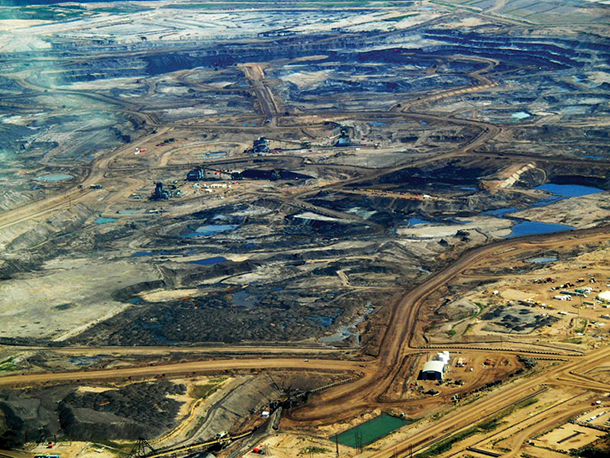
Tar sands surface mines in Alberta, Canada (Photo: Howl Arts Collective, Flickr CC BY 2.0)
CURWOOD: By the way, Minister Heurtel, when it comes to a carbon tax where does the revenue from that tax go in the Canadian system?
HEURTEL: Well, the Canadian system -- the federal government has said if you use -- if a province uses the federally imposed tax, well then the federal government has promised to redistribute those revenues to that province, and so that province will have a certain form of flexibility into what it does. In BC, for example, their system has been revenue neutral. So it's redistributed in certain elements of transitioning their economy coming out of fossils, but also there are, for example, tax breaks or tax advantages to offset the impact of the tax on the consumer. While I was in Québec, the cap-and-trade revenues are entirely reinvested in Québec's green fund which invests in programs to transition out of the fossil fuel-based economy to invest in clean tech, to invest in the electrification of transportation, for example, through our green fund, so through our cap-and-trade carbon market revenues, we can offer an $8,000 per person rebate for anyone wanting to buy an electric car. We're also in a network of charging stations. We already have 1,200 charging stations across Québec. We're investing in waste management, for example, so we have different areas. We have about 30 different orientations through our climate change action plan, which spends the money, which is generated from cap and trade. So, so far in almost three years now, we've generated over $1.4 billion through cap-and-trade, and that's reinvested in Québec's economy, into clean tech, into adaptation measures, into mitigation measures in a wide series of fields.
CURWOOD: Now, since Québec has been a pioneer in the cap-and-trade here in North America -- you partnered up with California, how is that deal going right now?
HEURTEL: Well, it's going very well. I remember when we linked up in 2014 there were a lot of naysayers and critics saying that it wouldn't work and we must say this partnership is been a tremendous. I was in Marrakesh a few weeks ago for COP 22, the international climate conference. I was there with my Californian counterparts along with Ontario and I think the best evidence of this partnership being truly a success is one: both parties been able to harmonize.
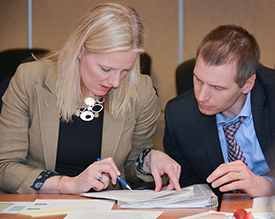
Catherine McKenna (left), Canada’s Minister of Environment and Climate Change, has vowed to make Canada’s electricity 90% free of carbon emissions by 2030. (Photo: Pembina Institute, Flickr CC BY-NC-ND 2.0)
Think about it, you have two infranational states, two states from national countries, one from Canada, one from the U.S., coming together on cap-and-trade, speaking two different languages and we've been able to harmonize our regulations, our laws and we've had now nine auctions, credit auctions because the cap-and-trade system, four times a year you auction off these carbon credits that companies have to buy to respect the laws and regulations regarding cap-and-trade, and these auctions have been very successful. The last auction just Québec which was last week, we announced the results of the last auction. We raised $155 million, and that's a very successful amount.
CURWOOD: And another state, Ontario, is ready to join. Is that correct?
HEURTEL: Yes, Ontario has not only announced that they will join the Québec California cap-and-trade system, but they've actually passed legislation. The Ontario legislature last Spring passed legislature that will let Ontario set up its cap-and-trade system, but we're working right now to link up with Ontario, and therefore Ontario will join the Québec-California system. So, now you're going to have over 50 percent of Canada's economy and over 60 percent of its population having the same cap-and-trade system, which will be linked to California. Last August, I was in Guadalajara, Mexico, for the Summit of the Americas on climate change. I was there representing Québec. Premier Kathleen Wynne of Ontario was there with me and we signed an agreement with Mexico, because Mexico has decided to set up its own cap-and-trade system similar to the Québec-California model and has indicated his intention to not only collaborate with Québec-California and Ontario but also to eventually link to the market.
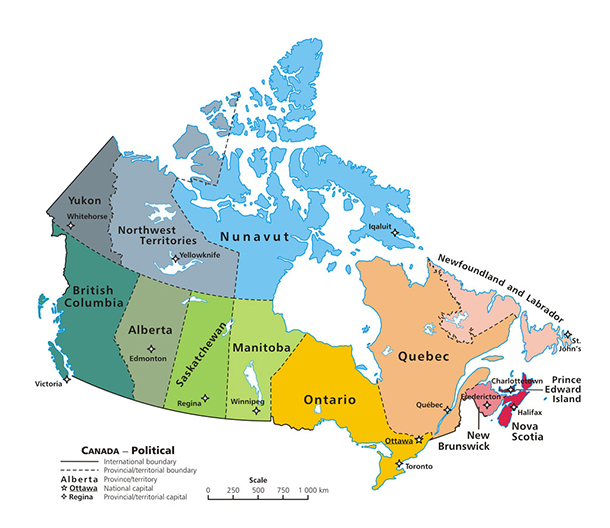
Only four of Canada’s ten provinces still rely on coal for energy: Alberta, Saskatchewan, Nova Scotia and New Brunswick (Photo: E Pluribus Anthony, Wikimedia Commons public domain)
So you're seeing from a North American perspective not only are you going to have over half of Canada with the same cap-and-trade system, but California which is the world's sixth largest economy, but now Mexico -- 123 million people -- wanting to join by 2018, 2019, and finally another key component is China, which is obviously the world's largest polluter and the world's second largest economy has announced that they will set up a national cap-and-trade system by 2018, and we've actually been working with China on their cap-and-trade system. They've sent a delegation to Québec twice now last year to learn from our system and to see how we can further collaborate.
CURWOOD: So, would this mean that if I bought a credit in Québec I might be able to use it in my factory in China?
HEURTEL: We're not there yet. No. I think that's still a ways off, but I think you're seeing from an North American perspective that there's more and more collaboration, not only in Marrakech, but throughout the past year I've had very good conversations with my counterparts in several U.S. states. We've even had European countries listed in our North American cap-and-trade system, and so what I think right now where we're at with China is more about exchanging information, exchanging data, collaborating and I think that's very encouraging for the future because ultimately what we're going to need to do -- all the nations, all the infranational states and national governments – eventually, once we get past this initial stage of adopting carbon pricing I think the next step is going to be harmonization. It's going to be about how we make sure that our systems collaborate with one another's, and I think that what we've started with China is very encouraging at that level.

David Heurtel has served as Quebec’s Minister of Sustainable Development, the Environment and the Fight Against Climate Change since December 2013. (Photo: Assemblée nationale du Québec)
CURWOOD: And I take it that not too long from now I can buy credit in Québec and use it in Guadalajara or in Veracruz.
HEURTEL: In Mexico, definitely, so what we're looking for...right now Mexico is already setting up a pilot project and we've been working with them along with Ontario and Mexico and California rather. And so, there's definitely a path there to get us to a place where we will be linked with Mexico, but we're looking maybe it will take a few years, but it's definitely in the foreseeable future.
CURWOOD: What about this buzz on the jungle telegraph that New York State might jump into the collaboration with Québec and Ontario and California?
HEURTEL: Well, that's an exciting development. Obviously, we are open to discussions there. It's a very exciting buzz. We've heard it too, but we know there's been some interesting discussions, let's say, that have occurred leading up to Paris and since Paris, and so we're continuing those conversations, but we're definitely interested in exploring ways of working much more closely together.
CURWOOD: David Heurtel is the Minister of Sustainable Development, the Environment and the Fight Against Climate Change. Thanks so much for taking the time with us today.
HEURTEL: Great to be with you, Steve. Thank you very much.
Related links:
- Washington Post: “Canada accelerates plan to phase out coal power, targets 2030”
- A past LOE interview with David Heurtel on Canada’s fossil fuel phase-out efforts
- The Toronto Star: “Liberals approve Trans Mountain pipeline, reject Northern Gateway plan”
- About David Huertel
[MUSIC: Aine Minogue featuring Tom Hill-clarinet, “Bruach Na Carraige Bana (At the Edge Of the White Rock),” on Celtic Meditation Music, Little Miller Music]
CURWOOD: Coming up...how air pollution credits could make for dirtier air in Western Pennsylvania. Stay tuned to Living on Earth.
Your comments on our program are always welcome. Call our listener line anytime at 617-287-4121. That's 617-287-4121. Our e-mail address is comments@LOE.org. And visit our web page at LOE.org. That's LOE.org.
ANNOUNCER: Support for Living on Earth comes from the Gordon and Betty Moore Foundation, and from a friend of Sailors for the Sea, working with boaters to restore ocean health.
[CUTAWAY MUSIC: Dr. John, “I’m an Old Cow Hand,” on Mercernary, J. Mercer/WB Music Corporation, EMI Records]
Beyond The Headlines

Thunderstorms in Melbourne, Australia in late November 2016 released excessive amounts of pollen that led to at least 8 deaths. (Albert Llausas, Flickr CC BY-NC-ND 2.0)
CURWOOD: It’s Living on Earth, I’m Steve Curwood. Time to look beyond the headlines now, with Peter Dykstra of DailyClimate.org and Environmental Health News, that's EHN.org. Peter’s on the line from Conyers, Georgia. Hi, Peter. What have you found?
DYKSTRA: Hi, Steve. Let’s start out with a new disease. It’s new to me, at least, and it has links to extreme weather events and since climate scientists say climate change will make such events harsher and more frequent, maybe climate change as well.
CURWOOD: Well, that sounds cheerful.
DYKSTRA: It’s springtime down under, and last week a heavy thunderstorm hit Melbourne, Australia’s second-largest city. That triggered an immense release of grass pollen, which in turn triggered something called “Thunderstorm Asthma.” At least eight people died and the city received 1,900 emergency calls in just four hours.
CURWOOD: Thunderstorm asthma? Has this ever happened before?
DYKSTRA: Yeah, it has but only in recent years. The first reported outbreak was in 1987 and it’s been reported in Europe as well from olive tree pollen in Italy, as well as other instances in Australia, though none of them have been this deadly. A few years back, a US government-funded study here in the Atlanta area found asthma attacks often increased immediately after thunderstorms.
CURWOOD: And so there’s possibly one more link between health and extreme weather caused by climate disruption. Hey, what else do you have?
DYKSTRA: Well, despite all the hand-wringing from the fossil fuel industry about how the Paris Climate agreement will wreck the economy, one big oil CEO said last week that he doesn’t think it will hurt their bottom line at all.

One of Shell Oil’s many gas stations. (Mike Mozart, Flickr CC BY 2.0)
CURWOOD: Well that’s kind of surprising, talking about good news for the economy and the environment?
DYKSTRA: Yes, it does kind of sound like good news, but it probably isn’t. Royal Dutch Shell CEO Ben van Beurden said Paris won’t hurt Shell’s valuation because they’ll be busy pumping every last drop of oil they own out of the ground and selling it. To be fair, unlike some of its big oil competitors, Shell has hedged its bets by investing heavily in renewable energy. By contrast, ExxonMobil has invested less in renewables than they paid their CEO in most years over the past decade, but even Exxon is beginning to look more seriously at things like fuel cell technology.
CURWOOD: Well let’s take our weekly look back at environmental history. What did you bring us?
DYKSTRA: Well, the legacy of U.S. nuclear weapons testing left its mark in several locations in the Pacific, in the Aleutian Islands, and of course there were hundreds of U.S. nuclear blasts – British tests too – at the test site north of Las Vegas. But fifty years ago this week, the second of two nuclear blasts detonated in a salt dome in Southern Mississippi.
CURWOOD: Whoa, Mississippi in the sixties…I’m thinking more of the Civil Rights movement, not the Cold War.

Horace Burge, who lived about two miles from the nuclear test site in Mississippi, came home to shattered dishes after the salt dome nuclear test in 1966. (Photo: Mississippi Department of Archives and History [No restrictions], via Wikimedia Commons)
DYKSTRA: Yeah, the first of the two tests took place in October, 1964 about a half mile beneath Lamar County, Mississippi. They called it Project Salmon, and its stated purpose was to turn an underground salt deposit into a huge cave. They evacuated 400 nearby residents -- paid them ten bucks per adult, the kids got out at half price for 5 bucks. Mission accomplished, they made the huge cave, but blast impact was much greater than expected on the surface. The Atomic Energy Commission received about 400 property damage claims after the blast, but they also received the thanks of pecan farmers in the area when thousands of pecans shook loose -- right in the middle of harvest time.
CURWOOD: So they got to pick pecans that year with a rake instead of a ladder, huh?
DYKSTRA: Yes, then 50 years ago, December 3, 1966, the second test took place inside the newly blasted salt cave. It was designed to be much smaller than the first blast, with a stated goal of seeing if a small nuclear blast could go undetected by other nations.
CURWOOD: So in effect, they were cheating in order to see if they would get caught?
DYKSTRA: Yeah, sort of. The U.S. conducted its last nuclear test in Nevada in 1992, but of course concerns about nuclear weapons in the hands of nations both big and small remain.
CURWOOD: As does an enormous cleanup project at nuclear weapons manufacturing sites. Peter Dykstra is with Environmental Health News, that’s EHN.org and the DailyClimate.org. Thanks, Peter. We’ll talk to you again real soon.
DYKSTRA: OK, Steve. Thanks a lot, talk to you again soon.
CURWOOD: And there’s more on these stories at our website, LOE.org.
Related links:
- U.S. thunderstorm asthma study
- Reuters: “Shell CEO expects no valuation hit from climate accord”
- Climate Change News: Major oil investments in renewables
- Mississippi History: Nuclear Blasts
[MUSIC: Dr. John, “Shut D Fonk Up, on Television, Mac Rebennack/Anthony Kiedis, MCA Group]
Making Plastic Can Increase Pollution
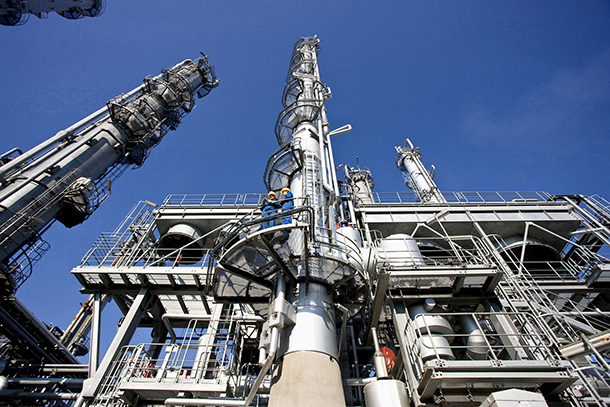
An ethane cracking facility in Ludwigshafen, Germany (Photo: BASF, Flickr CC BY-NC-ND 2.0)
CURWOOD: The Appalachian division of Shell Oil is building a $6 billion petrochemical complex 30 miles Northwest of Pittsburgh that will convert a byproduct of fracking into polyethylene, which is used to make everything from plastic bags to bottles to toys. This fracking byproduct is called ethane. And while this industrial facility is expected to create thousands of construction jobs and some 600 permanent ones, it is also forecast to increase air pollution in the region, thanks to what’s called an ethane cracker and the way its emissions are regulated. But first to explain the ethane cracker, here’s reporter Reid Frazier of the Allegheny Front.
FRAZIER: You might be wondering what is ethane, and what is an ethane cracker. To answer this question for myself, I paid a visit to this guy:
VESER: Hi, nice to meet you.
FRAZIER: Goetz Veser is a chemist at Pitt’s Swanson School of Engineering. He explained ethane is found with oil and natural gas underground. At normal temperatures and pressures. It’s a gas. And it comes from the same place that oil and natural gas do -- fossils.
VESER: Yeah I mean basically it's old organic mass. As we always joke, it's dinosaurs. It's plants --animals from – from geological times.
FRAZIER: There is a lot of ethane in the deep shale formations in Western Pennsylvania. It’s a simple chain of two carbon atoms surrounded by six hydrogen atoms.
VESER: And ethane itself is not a very useful chemical, which is why it's being sent to a so-called cracker.

Construction is taking place on the site where Shell is building an ethane cracker plant near Pittsburgh, PA. (Photo: Reid Frazier)
FRAZIER: Before it even gets to the plant, the ethane gets separated from methane. That is the main component is natural gas, the stuff that heats your furnace and burns on your stovetop. At the cracker, the ethane gets put into tubes and heated up to around 1,500 degrees.
VESER: So as you heat it up, you basically make this molecule wiggle around more and more wildly.
FRAZIER: As the molecule wiggles more and more, the bonds holding its atoms together stretch and get weaker.
VESER: You can almost imagine it like when you have two kids that kind of hold arms and swing each other around. I mean f they get too crazy and too wild at some point they just can't hold onto each other and fly apart. Sort of the same thing in a molecule here.
FRAZIER: This is the cracking part of the cracker, when the molecular bonds fly apart, the atoms rearrange themselves into something new called ethylene. The two carbon atoms form a double bond with one another in this ethylene molecule and his double bond is the key to why ethylene is so valuable.
VESER: This double bond is very reactive, and that makes ethylene an extremely useful and very very widely-used chemical.
FRAZIER: Ethylene reacts very easily with other chemicals, so it can be strung together in these long chains.
VESER: You basically take many of these double-bonded molecules and you use the double bond to connect them together, like Lego pieces.
FRAZIER: And when you snap all these ethylenes together, you get polyethylene. This is the ubiquitous plastic found in everything from milk containers, medical devices to detergents -- you name it.
VESER: You find it in medical equipment, in hospitals, you find it in food packaging industry...I mean it’s really -- it's hard, it’s almost impossible to imagine modern life without ethylene derivatives.
FRAZIER: And Shell’s ethane cracker will be one place where all these facets of modern life start to form, from a gas found deep underground.
CURWOOD: That’s reporter Reid Frazier. So now that we understand how an ethane cracker makes feedstock for plastic products, let’s take a listen now to more of his reporting as he explains why there are concerns that this new petrochemical plant could degrade local air quality.
FRAZIER: Jim Fabisiak is an environmental health scientist at the University of Pittsburgh. From his desk overlooking the Monongahela River, Fabisiak pulls out a sheet of paper with a simple line graph on it.
FABISIAK: If I could show you at least, one piece of data...
FRAZIER: The graph shows the amount of industrial pollution in Beaver County for volatile organic compounds, or VOCs. These are a broad class of chemicals that help form ground level ozone, or smog.
FABISIAK: And there's a steady improvement. So from 1999 to current, there's been about a 50 percent reduction in in VOCs released by industry over time okay, a significant progress in air quality.
FRAZIER: But beginning in 2016, it starts going up, and up, until the year 2021. That’s when Shell’s ethane cracker is slated to come online in Beaver County.
FABISIAK: Adding the cracker to this point in time moving forward brings the levels of VOCs released in Beaver County by industrial sources to levels greater than what was seen in 1999.
FRAZIER: In fact, with a projected 500 plus tons emitted per year, the plant would be the largest source of VOC pollution in western Pennsylvania, per EPA records, and it would be the third largest in the state, behind an oil refinery in Philadelphia and a Styrofoam plant in Reading. The next largest nearby VOC polluter is the Clairton Coke Works, checking in at 336 tons a year. In addition to this, the plan is classified as a major source of hazardous air pollutants like benzene and formaldehyde, which can cause cancer and other serious health problems. Fabisiak says these emissions are a concern, in particular because Pittsburgh’s air already fails to meet federal standards for several pollutants including ozone. But Shell and state officials say the cracker isn’t a threat to public health. Mark Gorog is head of the air quality program for the Pittsburgh regional office of the state department of environmental protection. He says since the Pittsburgh metro area doesn’t meet federal air standards, Shell is installing modern pollution controls and a leak detection system in the plant itself.
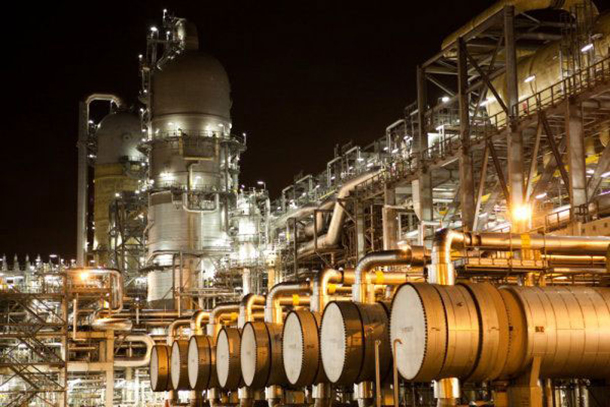
Nighttime at a Shell-owned ethane cracker facility in Singapore. (Photo: Penn State, Flickr CC BY-NC 2.0)
GOROG: So the technology they install has to meet latest and greatest, basically.
FRAZIER: In addition, the company had to show the DEP that its plant wouldn’t make the air unhealthy in surrounding areas.
GOROG: You know basically, they, you know, they modelled to show they will not cause or contribute to an exceedance of national ambient air quality standards and they did a risk estimate for air toxics which showed there was not going to be an undue risk to the public.
FRAZIER: On top of these measures, the company will buy more than 1,000 tons of pollution offsets to make up for the pollution offsets that will make up for emissions come from its smokestacks, storage tanks, and flares. These offsets are called Emissions Reductions Credits, or ERCs. They work kind of like a cap-and-trade system. The theory is that Shell will have to pay another company to clean up emissions at another facility, by buying credits from a plant that is either closing or installing pollution controls. But under state law, Shell is allowed to buy credits from plants that are already closed. Fabisiak says this means pollution that’s been gone from the region will be coming back in the form of emissions from the cracker plant.
FABISIAK: I don't see that as improving the air quality to any great extent. It's like three steps forward 2.99 steps back.
FRAZIER: For instance, the company is buying 70 tons of credits from FirstEnergy, for two coal-fired power plant units it closed in Armstrong County in 2012. It’s also buying 100 tons of credits from FirstEnergy’s closed Mitchell Power plant in Washington County, which ceased operations in 2013. Fabisiak says the best way for the system to work is if Shell would buy credits for future cuts to pollution for say, a company investing in pollution reductions at a power plant.
FABISIAK: If everyone's still staying in the area and operating, over time that results in slow decreases in the amounts of emissions over time.
FRAZIER: The DEP, which approved Shell’s plan, doesn’t see a problem with how the pollution credit system is working. By state law, plants that close have 10 years to sell their emissions credits. Gorog says new plants have to buy about 15 percent more credits than they will actually emit. So if Shell wants to emit 100 tons of pollution, it will have to buy credits for 115 tons. This means that gradually, emissions will go down, Gorog says.
GOROG: There's a certain pool of pollutants for the area, and gradually, over time, it shrinks over time, you know, what the design does is shrink the pool of emissions to bring the area into attainment.
FRAZIER: This won’t happen overnight. The DEP’s plans call for the region’s air to meet federal guidelines within five years. Krishnan Ramamurthy -- acting director of DEP’s bureau of air quality -- says there’s another aspect of the credit program. It incentivizes companies to clean up.
RAMAMURTHY: Because emissions reductions credits has a value, a cash value. So particularly it’s -- it's supply and demand.
FRAZIER: And if demand goes up for new plants to be built alongside the Shell plant, for instance, then the price of the credits will go up, too, and could encourage companies to close older, dirtier plants.
RAMAMURTHY: So they can really put additional controls to justify the control cost by selling some of the emissions reductions credits in the program.
FRAZIER: Shell, in an emailed statement, declined to say how much it spent on its emissions credits but emphasized the plant was built on the site of a zinc smelting plant, which had a heavy environmental impact of its own. Some of Shell’s credits, in fact, came from that plant, which closed in 2014. With or without Shell’s ethane cracker, DEP officials admit it won’t be easy for Pittsburgh to meet federal air standards in the near future. That’s because last year the EPA enacted stricter rules for ozone. I’m Reid Frazier.
CURWOOD: Reid reports for the Pennsylvania public radio program, the Allegheny Front.
Related links:
- Market Realist: About ethane’s importance for energy companies
- Allegheny Front: Ethane cracker explanation
- Allegheny Front: “Could Shell’s Ethane Cracker Erase Recent Gains In Air Quality?”
- Official VOC projections for Shell’s ethane cracker plant
[MUSIC: Dr. John, “I’m an Old Cow Hand,” on Mercenary, J. Mercer/WB Music Corporation, EMI Records]
CURWOOD: Coming up...how a smarter soybean could help fight hunger. That’s just ahead here on Living on Earth. Stay tuned.
ANNOUNCER: Funding for Living on Earth comes from you our listeners, and United Technologies -- combining passion for science with engineering to create solutions designed for sustainability in the aerospace, food refrigeration and building industries. UTC companies such as Otis, Carrier, Pratt & Whitney and UTC Aerospace Systems are helping to move the world forward. This is PRI, Public Radio International.
[CUTAWAY MUSIC: Dr. John, “Tangerine,” on Mercernary, J. Mercer/V. Schertziner/Famous Music Corp, EMI Records]
Note on Emerging Science: Engineering a High-Yield Soybean
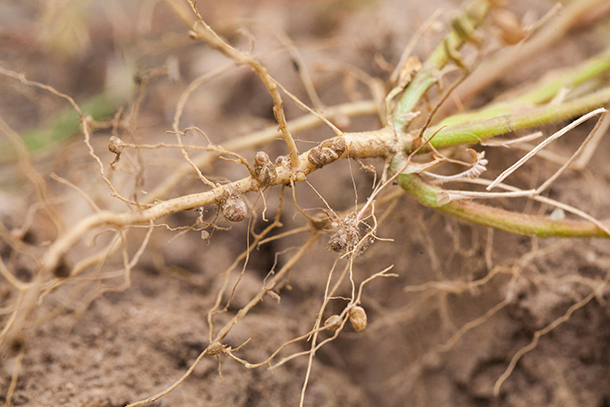
Root nodules in a legume plant containing nitrogen-fixing rhizobia. (Photo: Terraprima, Wikimedia Commons CC BY-SA 3.0)
CURWOOD: It’s Living on Earth, I’m Steve Curwood. In a moment, the blobs that are taking over the oceans. But first, here’s this week’s Note on Emerging Science from Alex Metzger.
[SCIENCE NOTE THEME]
METZGER: Legumes -- foods like beans, peas and lentils - are among the oldest cultivated plants on earth. Their historical roots date back 5,000 years to Mesopotamia, the birthplace of agriculture. These crops are packed with protein, fiber and other nutrients and currently account for 30 percent of the world’s agricultural production.
They also enrich the soil by converting nitrogen from the atmosphere into a form plants can use through a symbiotic relationship with root bacteria known as “rhizobia.” So many organic and conservation-minded farmers plant legumes instead of adding synthetic fertilizers to their fields.
This nitrogen-fixing ability is the basis of a recent scientific breakthrough. Researchers at Washington State University have doubled the growth of soybean plants. They genetically modified the plants to absorb nitrogen faster, and so triggered rhizobia in the roots to fix more nitrogen. This chain reaction created bigger, healthier plants that produced more seed. There was also evidence that these modified plants could be more efficient in drought conditions.
The researchers hope that this breakthrough could increase global food supply while cutting down on harmful synthetic fertilizers, and make for the best of both worlds: a better fed population and a healthier environment.
That’s this week’s note on emerging science: I’m Alexander Metzger.
CURWOOD: And by the way, in case you are wondering, those new soybeans were not modified to make them resistant to pesticides.
[SCIENCE NOTE THEME]
Related links:
- Washington State University News: Soybean nitrogen breakthrough could help feed the world
- Current Biology: Increasing Nitrogen Fixation and Seed Development in Soybean Requires Complex Adjustments of Nodule Nitrogen Metabolism and Partitioning Processes
- Capital Press: WSU researchers working to build a better soybean
Jellyfish Are Taking Over!
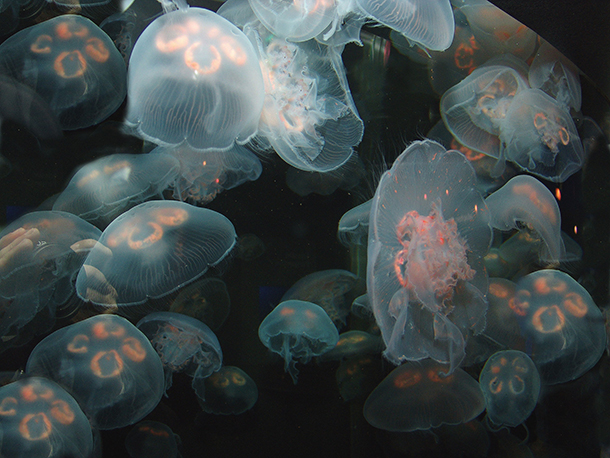
Moon jellies are named for their translucent, moonlike circular bells. (Photo: New England Aquarium)
CURWOOD: Most ocean species that are affected by humans are being harmed, not helped, by our presence. From overfishing to bycatch, to plastic pollution, to warming ocean temperatures, we’re changing the oceans in ways that are reducing the populations of everything from tuna to Right Whales to dolphins. Yet it appears that these threats to the very survival of many marine species may actually be helping one class of sea life: jellyfish. Australian–based biologist Lisa-ann Gershwin has a rare passion for this slimy, slippery, stinging sea-creature. In fact, she's personally identified 200 new species and is one of the foremost experts on these intriguing, but hardly cuddly beings. Speaking to Lisa-ann Gershwin at the New England Aquarium, Living on Earth’s Helen Palmer asked her what is so fascinating about jellyfish.
GERSHWIN: Oh, heavens. What's not? [LAUGHS] I'm drawn to several features about them. I love how beautiful they are. There's just something dreamy and otherworldly and mesmerizing about jellies and I've been drawn to that since the very first time I laid eyes on them. But as a scientist, I'm also drawn to how different they are and how unknown they are and they're incredibly primitive beings. You know, They've been around for a half a billion years, and that's pretty interesting. They've got a lot of aspects of their biology and ecology that are just fascinating, and yet they're so poorly studied and so poorly known that it's like every time you look at them you can discover amazing new stuff, and I really like that aspect as a scientist to be able to make so many discoveries of new species, new behaviors, new aspects of biology and ecology. It is kind of addictive to discover new stuff.
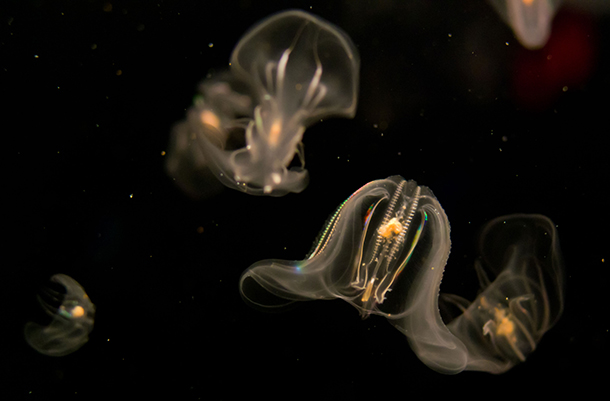
Comb jellies are actually in a separate taxonomic phyla (Ctenophora) than jellyfish (Cnidaria). (Photo: New England Aquarium)
PALMER: So, jellies, you call them jellies?
GERSHWIN: Yeah, jellies or jellyfish.
PALMER: Well, you say there's so much about them. They are indeed very strange, they look like nothing else. How do they work? How do they function?
GERSHWIN: Well, they function in ways that we simply can't relate to. They have no brain, no blood, no heart, no bones. Pretty much they’re just a bag of goo with a stomach and a really primitive nerve net and gonads. That's it.
PALMER: Gosh. So there are many, many, many of them and basically they all alike, they're these pulsating things that get around by taking in water and squeezing out water?
GERSHWIN: Well, no they're not. So, some of them have the umbrella sort of body with the hanging down tentacles and all that, and others have these really weird shapes that defy imagination called Comb jellies -- comb like comb your hair -- and they have these eight rows of cilia and refract the light into rainbows.
PALMER: Cilia are -- little fingers?
GERSHWIN: Yeah, little kind of...little hairs, and these they have these weird little plates of cilia and when the plates beat all rhythmically that's how they move. So, they don't go pulse, pulse, pulse like familiar jellies do. The comb jellies...it's more like tractor motion of these ciliary plates, and they send out these beautiful rays of light. They're just dreamy little things. But they are absolutely alien, and I mean, if believed in these beings from outer space, they would be it because they're weird. Some of them look like Klingon attack vessels, and some of them look like the batman logo, and some of them look like belts, and some of them look like a grape with two tentacles. Like, come on. How could you not love these?

The sting of the flower hat jelly is painful and leaves a bright rash. (Photo: New England Aquarium)
PALMER: Of course, we know jellyfish because we meet them in the sea and it's, "Ow!"
GERSHWIN: They do sting.
PALMER: Do all of them sting?
GERSHWIN: Just about all of them. Almost all jellyfish species have stinging cells, but many of the species that do have stinging cells, they're not able to inflict damage on us with a sting. Some are fairly mild, some are a little bit more ouchy, and some are fully, screamingly painful, and of course, some are actually deadly.
PALMER: You say they're half a billion years old. Have they changed vastly over that period of time, or don't we know because obviously they don’t persevere in the fossil record?
GERSHWIN: No, they do. That's what is so interesting. They do make fossils. They don't leave big meaty fossils like dinosaur legs. It's more like a footprint, and the fossils they leave do tell us quite bit about what they looked like, and the amazing thing is they look and act just like modern-day jellies. So, no they haven't changed and I find this absolutely fascinating. So if you think about -- since jellyfish have been around, about 585 million years that we know from fossil evidence, and about a billion years that we know from DNA evidence, so we know they've been around for a long, long, time and so this is what's so fascinating to me is that while other things have evolved into this staggering array of life. We've got things that swim, we've got things with fins, we've got things that have grown legs, we've got things that have walked on land and learned to breathe, we've got things that have created fur and feathers and wings and they've learned to fly, all this incredible array of animal life that has evolved in that time since jellyfish first swam the seas or well, drifted really, and they haven't changed because haven't needed to. So what they do works. It's that simple, but what's really amazing even more than that is what we are doing as a normal part of being human, you know, our waste and our coastal construction and our fishing and our carbon dioxide, all of these things. We are creating a world for jellyfish that they're loving. We are giving them the biggest break of their entire history.
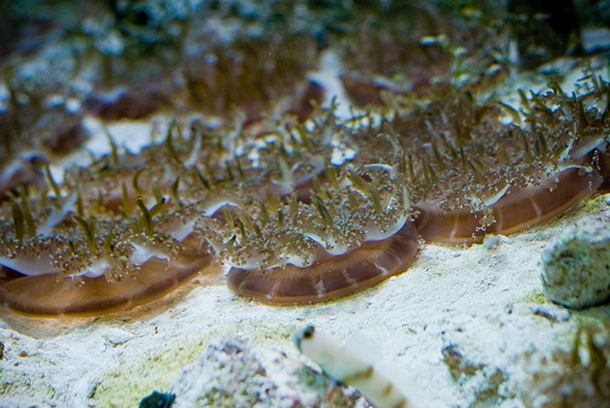
The “upside down jelly” is so named because it spends its life pulsing upside-down in shallow water, rather than swimming through the water. (Photo: New England Aquarium)
PALMER: I was going to ask you, in fact, what is the ideal circumstance for jellyfish? What would be an ideal sort of habitat for jellyfish? You tell me that we've basically created that for them. So what is it?
GERSHWIN: Absolutely, yeah. If you think about, if you're an animal and every day is a struggle to find food, a struggle not to be someone else's food, a struggle to grow fast enough to reproduce before you become food or die of some other way, imagine a world where somebody else does you the favor of taking out your predators and competitors. Well, that's pretty cool. And imagine a world where somebody else warms up the water that you're living in so you grow faster, eat more -- of course there's more food available because the competitors are gone, right -- you reproduce more and you live longer to do more of it. You would be pretty happy. Jellyfish don't have a brain, so I think they're not actually happy right, but man, they're loving it.
PALMER: So, we've basically done so much fishing of the top predators that the things that ate jellyfish aren't there so much anymore.

The sting from Pacific sea nettles causes pain similar in intensity to that of a bee sting. (Photo: New England Aquarium)
GERSHWIN: Yeah, so you think about jellyfish are eaten by turtles. Well, we've taken a lot of turtles, and a lot of turtles have died not necessarily only from fishing but by having less food available and by plastic and beaches having lights, and we're creating a world that's pretty hostile to turtles. So, fewer turtles more jellies. There's a fair few types of fish that only eat jellyfish, but we seem to be taking those out too, and a lot of crabs that eat jellyfish, and we're taking those out too -- like the Blue Swimmer crabs that's everybody's favorite crab. Yeah, those eat jellyfish, but we take a lot of those out.
PALMER: Well, I think many of us who have been swimming to our favorite swimming holes have discovered you can't go in because what's there? Lots and lots and lots of jellyfish. There really is a plague of jellyfishes.
GERSHWIN: They are having a renaissance in many, many places. Of course, not every place has been overrun by jellies of course, and of course not every species of jellyfish is absolutely rambunctious and out-of-control. Some species are actually suffering from the changes we're causing in the environment, but there are some jellies that are doing really, really, really well, and they're just causing untold problems for all sorts of marine industries from tourism where they are stinging people or people are afraid of being stung to power plants that are having emergency shutdowns to salmon farms to fishing vessels and, of course, ecosystems that are being taken over with jellyfishes as the top predator and just bends your mind backwards. Like you think about, hang on, jellyfish is the top predator...what about fish and sharks and whales? It's not that they're eating sharks, but they eat the food that the food of the food of sharks would eat, and so jellyfish are able to cripple an ecosystem at the ankles.
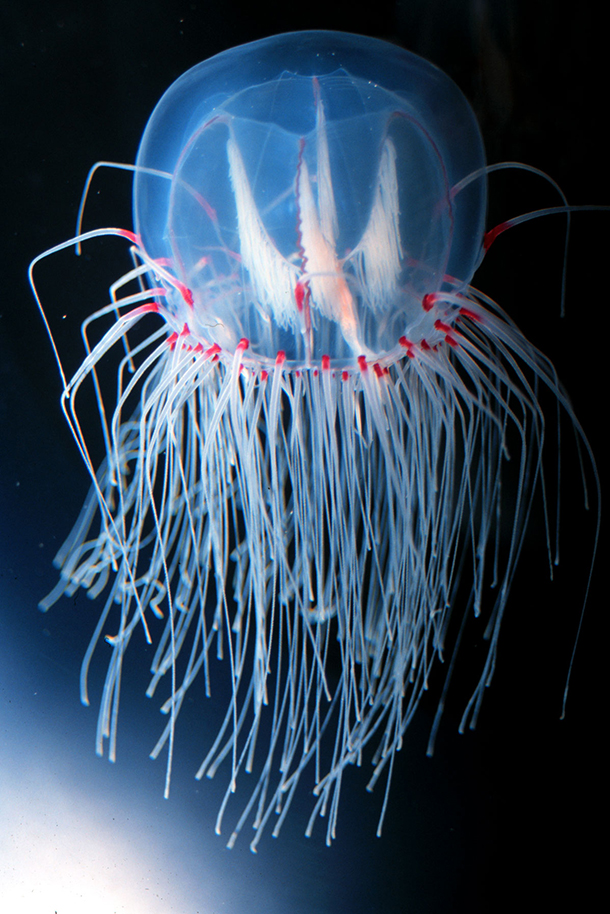
The bell jelly is not a true jelly but rather is a hydromedusa. (Photo: New England Aquarium)
PALMER: So, they basically are eating the plankton, which would've fed the little fish which would've fed the bigger fish which would've fed the shark?
GERSHWIN: That's exactly right...or maybe one or two more levels in there, but yes, jellyfish are eating the eggs and larvae of a quite large species and they also eat the plankton that the larvae would eat. So, yeah this double whammy of creation competition is pretty incredible, simple but incredible.
PALMER: Now there're other problems the jellyfish cause, in particular, why did they cause problems for power plants?
GERSHWIN: Yeah, so power plants seem to be a really interesting thing with jellies. So basically it goes like this. You got a power plant, might be nuclear might be coal-fired might be whatever, but if it draws cooling water from the ocean or an estuary, or anything where jellyfish could conceivably be, when jellyfish bloom into super abundances these power plants suck in all these jellies and the engines that are cooled by the sea water shut down. It could be potentially catastrophic if the plant weren't shut down proactively.
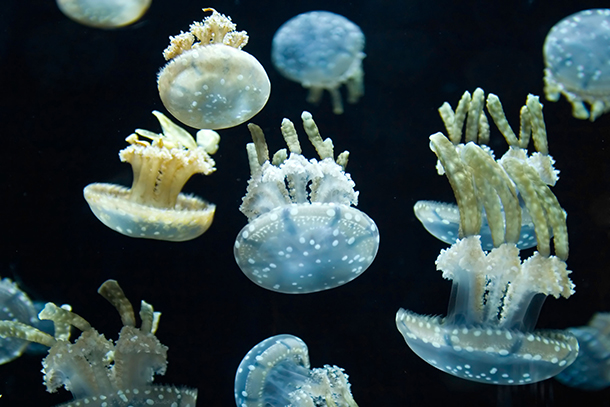
Lagoon jellies feed on zooplankton but also grow symbiotic algae in their tissues as an added food source, giving them a greenish-brown color. (Photo: New England Aquarium)
PALMER: So we have managed to create for ourselves a real problem with these creatures that you really love. What can we do about it?
GERSHWIN: Well, I get this question a lot as you might imagine. There are people making a lot of money developing products based on jellyfish to stimulate fishing of jellyfish, and I say, "Go for it." Seriously, I think it's great. I don't have any problem with that. Some of them are a bit misguided, but I mean, we have to learn that way, right, but there are some that I think are really good products that are useful and I'm completely supportive.
PALMER: Things like...
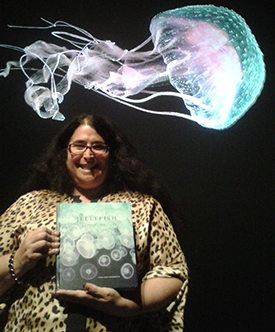
Dr. Lisa-ann Gershwin is the author of Stung!: On Jellyfish Blooms and the Future of the Ocean and has discovered 200 species of jellyfish. (Photo: Helen Palmer)
GERSHWIN: Things like paper towels, you know, jellyfish are highly absorbent. Things like a fat free egg replacement for baked goods. So some of these things are actually quite interesting, and of course, Asian cuisines have been using jellyfish as a delicacy for thousands of years, but I don't think it'll change the fact of the blooms. Even if they fish out a particular species, the next one in line will take its place. I think if we really want to change this dynamic, we have to actually change the reasons the jellyfish are blooming.
They're not blooming because they're evil. They bloom as a natural part of their lifecycle, and they respond to environmental conditions. They're blooming because the things that we are doing as humans is giving them the perfect conditions to bloom. So, as long as we keep giving them fewer fish, warmer water, more nutrients in coastal ecosystems, more coastal construction, etcetera, etcetera, they're going to continue to bloom because that's what they do.
CURWOOD: Lisa Ann Gershwin, in conversation with Living on Earth’s Helen Palmer. For photos of the Rainbow Comb jellies and other species, visit our website, LOE.org.
Related links:
- Smithsonian Institute: Jellyfish and Comb Jellies
- Watch a jellyfish bloom
- Bloomberg: “Massive Swarms of Jellyfish Are Wreaking Havoc on Fish Farms and Power Plants”
- Haaretz: Turning jellyfish into industrial raw material
- About Lisa-ann Gershwin
- About the New England Aquarium
BirdNote: Frigatebirds Are Seafaring, But Water-Averse
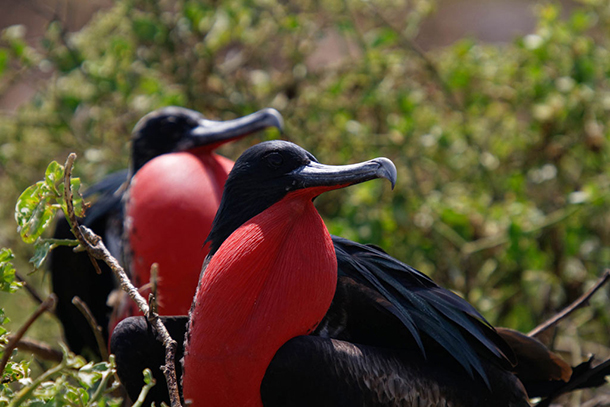
Two Frigatebirds perched in greenery. (Photo: Ronald Woan)
[BIRDNOTE THEME]
CURWOOD: Time for a flight of fancy now, way up over the warm southern oceans with one of the most iconic and breathtaking of all tropical sea birds. But as Michael Stein explains, this is a sea bird with an unusual aversion to the actual water.
BirdNote®
Frigatebirds: Seabirds That Can’t Get Wet
[Magnificent Frigatebird, http://macaulaylibrary.org/audio/136235, 0.13-18]
STEIN: Soaring above the warm oceans of the world, frigatebirds cut a distinctive profile: huge, slim, angular black birds with a 7-foot wingspan and long, scissor-like tails. They blithely chase down smaller birds like boobies to steal their fishy prey or drop to just above the surface and snatch fish from the water. Perched atop a rocky islet or dead mangrove tree, they look like seagoing vultures.
But one thing you’ll never see is a frigatebird floating on the ocean. Because their feathers -- unlike those of nearly all other seabirds -- are not waterproof.
Instead, the frigatebird is a master of staying aloft. Tracking devices placed on frigatebirds near Madagascar showed that they often stay in the air for a month and half at a time! They’ll soar above the ocean, riding a complex roller coaster of air.

Frigatebird in flight. (Photo: Charles Davies)
Intentionally flying into a cumulus cloud, which has a powerful updraft, they may rise as high as 2½ miles into the frigid atmosphere. From this high point, a frigatebird can glide more than 35 miles without flapping its wings.
Which is how this seabird that can’t get its feathers wet -- survives over the open ocean.
[Magnificent Frigatebird calls, http://macaulaylibrary.org/audio/136232, 0.05-.08]
###
Written by Bob Sundstrom
Bird sounds provided by The Macaulay Library of Natural Sounds at the Cornell Lab of Ornithology, Ithaca, New York. [136235 and 136232] recorded by Martha J Fischer.
BirdNote’s theme music was composed and played by Nancy Rumbel and John Kessler.
Producer: John Kessler
Executive Producer: Sallie Bodie
© 2016 Tune In to Nature.org November 2016 Narrator: Michael Stein
CURWOOD: For pictures of these majestic frigate birds, coast on over to our website, LOE.org.
Related links:
- Hear this segment on the BirdNote website
- More on Frigatebird flight
[OCEAN WAVES]
We leave you this week on a secluded beach along the central California coast.
[OCEAN WAVES]
The mesmerizing sounds of the Pacific at Big Sur. If you listen closely, you'll hear some barking sea lions as well.
[OCEAN WAVES]
Bernie Krause recorded them for his Wild Sanctuary CD, “Ocean Dreams.”
[“Ocean Dreams” Wild Sanctuary 2002]
CURWOOD: Fish farming is big in China, and there have been lots of questions about hygiene and quality. One tilapia farmer has a novel plan to reassure consumers.
FARMER: We will now proceed to do something no one in the industry has done before -- put a camera system into the farm area. A customer who buys a bag of fish, you have a QR code in the bag. Please take our challenge. Run your smart phone through our QR code on the back and you have a chance to see the actual farm raised this fish in your bag and how it's being raised. Tap on 24 hours a day and stay as long as you like, and see what we do to the farm and the fish in the farm.
CURWOOD: The promise of better quality in the new wave of fish-farming in China. Next time on Living on Earth.
[MUSIC: Mark Mothersbaugh. “Kite Flying Society” Rushmore (Original Motion Picture Soundtrack) 1999 Island Def Jam]
CURWOOD: Living on Earth is produced by the World Media Foundation. Our crew includes Naomi Arenberg, Bobby Bascomb, Aidan Connelly, Savannah Christiansen, Jenni Doering, Jaime Kaiser, Don Lyman, Alex Metzger, Helen Palmer, Adelaide Chen, Jennifer Marquis and Jolanda Omari. Tom Tiger engineered our show, with help from Jeff Wade, Jake Rego and Noel Flatt. Alison Lirish Dean composed our themes. You can hear us anytime at LOE.org -- and like us, please, on our Facebook page – it’s PRI’s Living on Earth. And we tweet from @LivingOnEarth. I'm Steve Curwood. Thanks for listening!
ANNOUNCER1: Funding for Living on Earth comes from you, our listeners, and from the University of Massachusetts, Boston, in association with its School for the Environment, developing the next generation of environmental leaders. And from the Grantham Foundation for the protection of the environment, supporting strategic communications and collaboration in solving the world’s most pressing environmental problems. Support also comes from the Energy Foundation, serving the public interest by helping to build a strong, clean, energy economy, from Gilman Ordway, and from SolarCity, America’s solar power provider. SolarCity is dedicated to revolutionizing the way energy is delivered by giving customers a renewable alternative to fossil fuels. Information at 888-997-1703. That’s 888-997-1703.
ANNOUNCER2: PRI. Public Radio International.
Living on Earth wants to hear from you!
Living on Earth
62 Calef Highway, Suite 212
Lee, NH 03861
Telephone: 617-287-4121
E-mail: comments@loe.org
Newsletter [Click here]
Donate to Living on Earth!
Living on Earth is an independent media program and relies entirely on contributions from listeners and institutions supporting public service. Please donate now to preserve an independent environmental voice.
NewsletterLiving on Earth offers a weekly delivery of the show's rundown to your mailbox. Sign up for our newsletter today!
 Sailors For The Sea: Be the change you want to sea.
Sailors For The Sea: Be the change you want to sea.
 The Grantham Foundation for the Protection of the Environment: Committed to protecting and improving the health of the global environment.
The Grantham Foundation for the Protection of the Environment: Committed to protecting and improving the health of the global environment.
 Contribute to Living on Earth and receive, as our gift to you, an archival print of one of Mark Seth Lender's extraordinary wildlife photographs. Follow the link to see Mark's current collection of photographs.
Contribute to Living on Earth and receive, as our gift to you, an archival print of one of Mark Seth Lender's extraordinary wildlife photographs. Follow the link to see Mark's current collection of photographs.
 Buy a signed copy of Mark Seth Lender's book Smeagull the Seagull & support Living on Earth
Buy a signed copy of Mark Seth Lender's book Smeagull the Seagull & support Living on Earth

